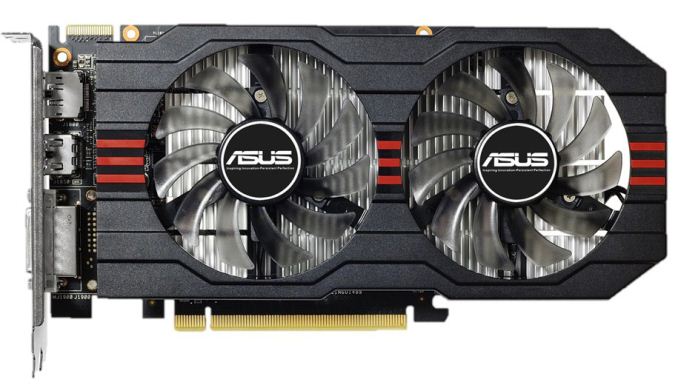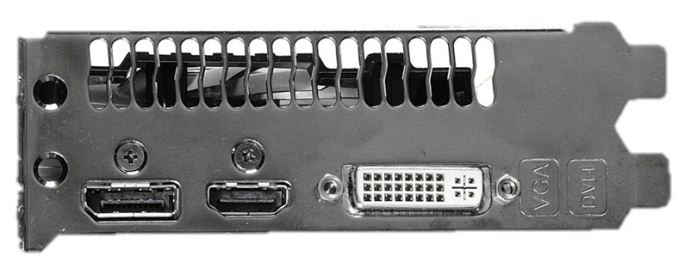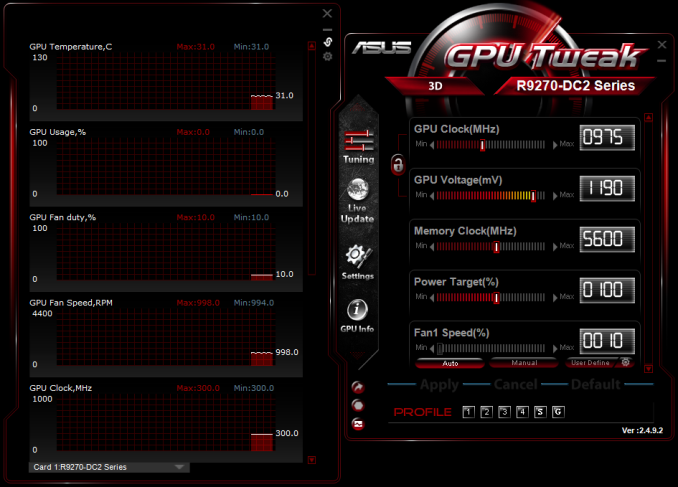The AMD Radeon R7 265 & R7 260 Review: Feat Sapphire & Asus
by Ryan Smith on February 13, 2014 8:00 AM ESTMeet The Asus Radeon R7 260
Our other card of the day is our R7 260 sample from AMD, which comes in the form of a complete retail card: Asus’s Radeon R7 260. This is a standard retail card, featuring a solid design but no factory overclock or other frills.
Surprisingly for a 95W card, Asus’s card is a dual fan open air design. Based on a variation of their dual fan coolers, Asus utilizes a relatively simple aluminum heatsink directly mounted to the Bonaire GPU beneath. This heatsink has a large base that serves to cover the RAM, but not the VRMs towards the front of the card, and mushrooms out at the top to form a larger surface for the dual fans to cool. Truth be told we were pleasantly surprised by this design; these larger dual fan designs are uncommon for sub-100W cards, and even with the relatively simple heatsink it’s essentially oversized for the GPU in question, though as we’ll see in our noise results this is clearly to the benefit of the user.
As a result of using such a large cooler on such a small board, the Asus R7 260’s cooler significantly overhangs the PCB. The PCB itself is just 6.8” long, while the cooler extends a further 1.9” to give the card a total length of 8.7”. As is usual for Asus, the card feature’s Asus’s Super Alloy Power discrete electrical components for enhanced durability. Meanwhile the fact that this is closer to a card strapped to a cooler than a cooler strapped to a card doesn’t do Asus any favors, especially since the GPU is towards the rear of the card. The short length of the card ensures it’s rigid enough, but there’s some opportunity for flexing towards the front of the card.
For Asus’s power connectivity, the single 6-pin PCIe power socket is found at the end of the card, orientated parallel to the PCB despite the significant overhang of the cooler. To make up for this, Asus has once again reversed the PCIe power socket so that the tab on the plug faces inwards instead of outwards, which makes this design practical as the cooler no longer blocks the tab.
As for Asus’s display I/O, Asus is using a simpler port layout that occupies just a single slot, presumably so that this PCB is capable of being used on single-slot designs if necessary. This results in the card having 1x DL-DVI, 1x HDMI, and happily enough for such a low-end card, 1x DisplayPort, as opposed to a VGA port. This gives the Asus card the ability to drive three digital displays at once for Eyefinity, or even a single 4K display if we’re talking about simple desktop work.
Meanwhile on the software side of things the R7 260 comes with Asus’s standard GPUTweak software utility. GPUTweak is a very competent overclocking suite that offers all of the overclocking and monitoring functionality we’ve come to expect from a good overclocking utility, including a wide array of monitoring options and support for GPU voltage control. Asus’s taste in skins is unfortunate – a low contrast red on black – but otherwise the UI itself is similarly solid. To that end GPU Tweak won’t match Afterburner on some of its more fringe features such as recording and overlays, but as a pure overclocking utility it stands up rather nicely.
Wrapping things up, as one of the only two R7 260 graphics cards currently Asus is both enjoying and being disrupted by the lack of sensible pricing among R7 260 cards. At a current retail price of $139 the Asus R7 260 is a full $30 (28%) over what should be a $109 MSRP for an R7 260 card, and $15 more expensive than the alternative MSI card. More importantly, it’s currently just as expensive as the more powerful R7 260X, which puts this card in an unfortunate spot since you can easily buy a more powerful card for less. Asus can enjoy a small premium from a good design and their 3 year warranty, but this is an especially treacherous position if R7 260X prices quickly come down to $119.
Finally, on a quick technical note we do want to point out that we have encountered one minor oddity with the Asus R7 260 that as of this writing is still being looked into by AMD. The card we received has its GPU idle clockspeed at 550MHz, instead of the 300MHz clockspeed that is common for all other AMD GCN cards, including their other Bonaire cards. The ramifications of this are minimal as it doesn’t affect the load performance of the card in any way, but it does mean the card is technically running at a higher clockspeed than it should at idle, which can affect idle power consumption. We’re seeing 74W at the wall, the same as our reference R7 260X, but our GPU testbed is admittedly not well suited to picking up small fluctuations in idle power consumption like this on such a low powered card. In any case we don’t believe it to be a dealbreaker, but AMD is currently looking into it to try to determine what’s going on.














52 Comments
View All Comments
TheJian - Wednesday, February 19, 2014 - link
How is that possible when all of the pricing is fake? You are ignoring REAL pricing much like anandtech. They should draw conclusions based on REAL pricing, and ignore ALL companies MSRP. If I can't buy it, it's still fake until I can for MSRP. IE, 290x is $700 right now (actually $709 cheapest on amazon - 3 in stock), NOT $550. So reviews based on $550 pricing are not real. Anandtech continues to give the benefit of the doubt 'one day it might be MSRP and a good deal if they can get to MSRP quickly'...LOL. Is a $709 290x a good deal vs. 780ti? NOPE.thejoelhansen - Saturday, April 26, 2014 - link
I hope I didn't overlook something obvious, but are the GTX 760 results missing?